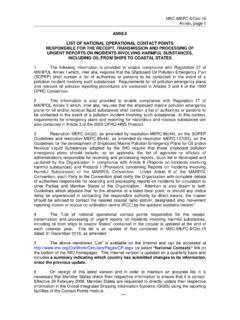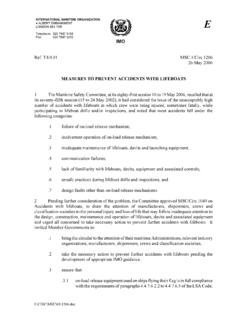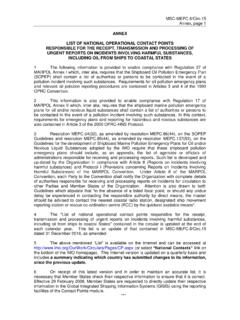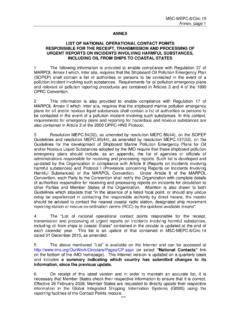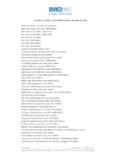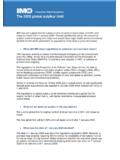Transcription of Ref. T4/4.01 MSC.1/Circ.1205 26 May 2006
1 INTERNATIONAL MARITIME ORGANIZATION. 4 ALBERT EMBANKMENT. LONDON SE1 7SR E. Telephone: 020 7587 3152. Fax: 020 7587 3210. IMO. Ref. T4 26 May 2006. GUIDELINES FOR DEVELOPING OPERATION AND MAINTENANCE. MANUALS FOR LIFEBOAT SYSTEMS. 1 The Maritime Safety Committee, at its eighty-first session (10 to 19 May 2006), taking into account the number of casualties with lifeboat systems, further recognizing the need to improve manuals for operation and maintenance of lifeboat systems, and having considered proposals by the Sub-Committee on Fire Protection at its fiftieth session, approved the Guidelines for developing operation and maintenance manuals for lifeboat systems, as set out in the annex. 2 Member Governments are invited to bring the annexed Guidelines to the attention of all parties concerned with their application, as appropriate. **. I:\ circ \MSC\01\ ANNEX. GUIDELINES FOR DEVELOPING OPERATION AND MAINTENANCE. MANUALS FOR LIFEBOAT SYSTEMS.
2 1 Scope and purpose of the guidelines Seafarers often change ships and sometimes are not familiar with the lifeboats on their ships. Casualties with lifeboat systems are often caused by poor understanding of the lifeboat systems, especially release gear systems. User-friendliness of manuals for lifeboat systems is, therefore, important to help prevent casualties. The purpose of these guidelines is to encourage development of user-friendly manuals for operation and maintenance of lifeboat systems including launching appliances. These manuals should be easy to understand. The guidelines demonstrate the appropriate level of detail and use of illustrations in explaining the safe use of critical systems. Manufacturers of lifeboats and launching/recovery appliances are invited to make manuals easy to understand, taking into account these guidelines. The use of video materials in conjunction with printed manuals can be an effective tool for mariners who may not be inclined to read a manual.
3 These guidelines are not applicable to the emergency instructions required by SOLAS regulation III/8, operating instructions such as posters and signs required by SOLAS regulation III/9 or other brief instructions for operation of lifeboats. These guidelines are for manuals to be carried on ships for use by seafarers, and accordingly the section on weekly and monthly inspection and maintenance does not refer to detailed maintenance/repair work. Detailed maintenance/repair work should be conducted by the manufacturer's representative or a person appropriately trained and certified by the manufacturer for the work in accordance with 2 Collaboration of manufacturers of the lifeboat and the launching appliance A manual for a lifeboat system including launching appliance should be developed with the collaboration of manufacturers of the lifeboat and the launching appliance and preferably be a single document. As a minimum, the use of different words for the same gear/parts of the lifeboat system should be eliminated by the collaboration of manufacturers of the lifeboat and the launching appliance to prevent misunderstanding by seafarers.
4 Hereafter, these guidelines assume a manual for a lifeboat system includes the launching appliance as a minimum, but separate lifeboat, release gear, and launching appliance manuals may be effective if adequately co-ordinated and using the same style of presentation per these guidelines. 3 Contents of a manual for a lifeboat system Items to be included An operation and maintenance manual for a lifeboat system should include, as a minimum, the following items: .1 overview and specification of the lifeboat system;..2 explanation of the structure and working principle of the major parts of the lifeboat system including release gear systems;. I:\ circ \MSC\01\ ANNEX. Page 2..3 operation of the lifeboat system; and .4 routine inspection and maintenance of the lifeboat system. Organization, description and layout of manual Outline It is recommended that a manual for a lifeboat system be developed with the following major divisions: 1 General description of the whole lifeboat system.
5 2 Method of checking proper closure of release hooks. 3 Launching operation. 4 Recovery operation. 5 On-load/off-load release gear. 6 Inspection and maintenance. Explanation of major components and their function The structure and working principle of the lifeboat's major components, in particular the on-load/off- load release gear, should be explained using figures and preferably three-dimensional perspectives. In addition, the operation of the release gear should be described sequentially, using short phrases written in the active voice. Operation of lifeboat system including release gear systems The operation of the lifeboat system should be described using the following elements: .1 flow of the operation should be explained;..2 detail of operation should be explained with figures. Operation and relevant movement of the parts of the release gear should be described with illustrations/photos, preferably using annotations and arrows to show direction of movement; and.
6 3 hazards, precautions and notes should be identified with symbols specific to the level of risk. As an example of the various levels of risk and the appropriate associated symbols, the following are recommended: .1 For the highest level of risk, such as in the explanation of on-load release operation , the following symbol (red background) should be used with a warning statement similar to the following: I:\ circ \MSC\01\ ANNEX. Page 3. This operation releases the lifeboat and may result in the lifeboat dropping and causing death or serious injury if released too soon. Warning Note: International standard symbols (ISO 3864-1 and ISO 7010) are recommended where appropriate, but since marine use is excluded from the scope of these standards, and they fail to indicate different levels of risk, the graduated symbols are recommended..2 For the second highest level of risk, such as in the explanation of davit arm stop release operation , the following symbol (yellow background) should be used with a caution statement similar to the following: Incorrect or incomplete resetting may cause the lifeboat to drop resulting in death or serious injury.
7 Caution .3 For less critical mandatory instructions the following symbol (blue background) should be used with appropriate instruction: Place the manual gripe out of the way to prevent tangling round the lifeboat.. Mandatory .4 Important notes may be emphasized with symbol and style of instructions similar to the following: In case the hook is not released by the above operations, confirm condition of each hook and whether the boat is waterborne or not. Even though the hooks cannot be released by the above mentioned off- Note load release operation, the on-load release procedure, described in the following pages, is possible..5 Prohibited actions should use the following symbol (coloured red) and style of instruction: Never enter lifeboat without ensuring complete closure of release hooks. Incomplete resetting of the release hooks can cause the lifeboat to drop and may result in the death of occupants. Never I:\ circ \MSC\01\ ANNEX. Page 4.
8 Inspection and maintenance The items for weekly and monthly inspection/maintenance and other inspection/maintenance should each be explained separately. 4 Improvement of user-friendliness of a manual Use of figures/photographs Figures, preferably coloured, or photographs should be used as far as practicable to make manuals easy to understand. Use of standard wording The following standard wording should be used to explain lifeboat systems where provided, and for each of the applicable items illustrations should be provided to show the items and their location in the lifeboat or on the ship. The use of alternative terms for variety should be avoided, except to further define or clarify a term so that the reader never has to guess what item or system is being discussed..1 Davit/winch: .1 Auto releasing gripe .2 Davit arm .3 Davit arm stop .4 Davit remote control wire handle .5 Frame .6 Maintenance (hanging off) pennant attachment points, if provided.
9 7 Manual gripe, if provided .8 Remote control wire .9 Winch manual brake safety pin .10 Winch hand crank handle .11 Winch centrifugal or lowering brake .12 Winch hand brake or stop brake lever .2 Freefall: .1 Roller or sliding pad .2 Sea lashing rope .3 Emergency release device .3 Release gear: .1 Hook control cable .2 Hook retainer (lock piece)..3 Hydrostatic interlock .4 Hydrostatic interlock lever, if provided .5 Interlock ( mechanical protection of on-load release)..6 Maintenance (hanging off) pennant attachment points, if provided .7 On-load release .8 Release handle I:\ circ \MSC\01\ ANNEX. Page 5..9 Release handle closed (locked) and open positions .10 Release handle safety pin ..11 Release hook (hook unit) (fore and aft hooks)..12 Reset lever, if provided .13 Safety latch (keeper)..4 Suspension: .1 Foul weather recovery strops .2 Suspension block .3 Suspension link (lifting ring)..5 Officer in charge of lifeboat 5 Example of an operation and maintenance manual for a lifeboat system An example of an operation and maintenance manual for a fire-protected lifeboat system is attached in the following pages just for reference.
10 It demonstrates the suitable level of detail that should be expected for manuals. It should be noted that lifeboat systems are different from each other and some specifications in the example manual are not applicable to lifeboat systems of other types. The example attached at appendix is a model manual which is recommended as an example for developing specific manuals for lifeboat systems launched by falls, but the same general principles should be used for manuals for freefall lifeboat systems. **. I:\ circ \MSC\01\ ANNEX. Page 6. APPENDIX. EXAMPLE OPERATION AND MAINTENANCE MANUAL FOR A LIFEBOAT. SYSTEM*. Table of contents 1 General 2 Method of checking proper closure of release hooks 3 Launching operation Preparation before launching Setting painter Release of safety pin for winch hand brake lever Release of davit arm stop Boarding the lifeboat Launching procedure Release gear operation Painter release and lifeboat operation 4 Recovery operation Resetting procedure of release hook Recovery procedure Stowage procedure 5 On-load/off-load release gear system General Fore and aft hook units Release handle unit Hydrostatic interlock unit 6 Inspection and maintenance General precautions Inspection and maintenance of lifeboat and release gear system Inspection and maintenance of launching appliances (davits and winches).

